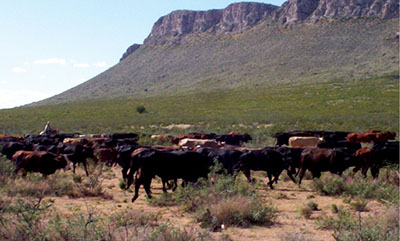Guide B-233
Craig Gifford, John Wenzel, and Jerry Hawkes
College of Agricultural, Consumer and Environmental Sciences, New Mexico State University
Respectively, Extension Beef Cattle Specialist, Department of Extension Animal Sciences and Natural Resources (EASNR), New Mexico State University (NMSU); Extension Veterinarian, EASNR, NMSU; and Dean, School of Science, Casper Community College. (Print Friendly PDF)
Introduction
Trichomoniasis (trich) is a venereal disease of cattle that can cause economically devastating losses in a short period. Trichomoniasis is caused by the protozoa Tritrichomonas foetus, and does not cause clinical signs in cows or bulls. There is no treatment for infected animals, making the disease difficult to control if proper preventive practices are not followed.
A susceptible cow that is bred by an infected bull will likely become infected with the organism, and will generally abort and then resume cyclicity, thereby infecting all bulls that breed her while she is infected. Most cows eventually clear the infection and are able to become pregnant. Both acute and chronic infections in bulls will likely transmit the disease to the cows during breeding, and the disease can spread rapidly through the herd. Trichomoniasis is known to reduce herd fertility, and the economic impacts from reproductive losses can be substantial for the livestock enterprise, with extensive implications for both production and economic sustainability. However, the full extent of economic damages associated with a trich outbreak in New Mexico livestock operations has not been evaluated.
Therefore, a series of factors that are impactful to the economic profile of livestock operations were considered in a recent survey of known trich-positive areas across New Mexico. Physiological factors that were found to be most economically impacted included calf crop percentage, conception rate, cull rates, weaning weights, and re-establishment of the herd. Impacts associated with trichomoniasis are not a one-year recovery process, but rather a long-term situation that requires intensive management by the livestock producer to return to profitability.

John Wenzel and courtesy of Hurt Cattle Company.
Cost and Return Estimate
A representative livestock enterprise was employed in the modeling process using the New Mexico State University cost and return estimate generator. The representative ranch had 400 mother cows, a 1:20 bull/cow ratio, a 15% replacement rate, and a 91% weaned calf crop. The comparative analysis cost and return estimate for a trichomoniasis-infected herd had the same number of mother cows and bull/cow ratio, a 35% replacement rate, and a 64% weaned calf crop. The values applied in the modeling process for the trich-infected herd were determined through survey responses from ranches recovering from the disease.
Economic Implications of Trichomoniasis in New Mexico
The percentage of weaned calves in the trich-positive ranches across New Mexico fell by almost 37% after the disease was identified. Economic impacts associated with fewer calves are multi-faceted for the production unit. First, the reality of selling fewer calves has a significant impact on the return for the enterprise. Second, due to New Mexico’s extreme environments, most producers find it necessary to raise their own replacement heifers in order to match their animals to the environment. Infected New Mexico herds reported that it was necessary to purchase replacement heifers due to reduced heifer crop production. A reduction in weaned calves will constrain the producer’s decision-making process as forward planning evolves. Not only were fewer calves weaned, but market calves were lighter with the presence of trichomoniasis, thus further reducing gross returns. The result of lighter calves was approximately $21 per cow. Overall, this research model indicated that economic impacts of trichomoniasis were in excess of $400 per cow on the representative livestock enterprise.
Conception rates were 90.55% for the disease-free enterprise and 64.5% for the trich-infected enterprise. The physiological and economic impact is stated in weaned calves. When the disease is present, effects on conception are significant. Conception may be delayed by several cycles. It is estimated that every cycle that a cow does not breed reduces her calf’s weaning weight by as much as 50 pounds. In addition, many cows will not rebreed and will have to be sold as open cows. Cows that were pregnant at pregnancy check may abort at any point up to 240 days of gestation1. Perhaps most devastating is the loss in calf crop, which can be 10–50% the first year depending on the rate of transmission in the herd, which is largely dependent on the number of infected bulls.
Replacing the aggregate breeding herd holds economic challenges that are both financial and genetic. Trichomoniasis has been shown to alter the genetic composition of the breeding herd. New Mexico producers must select for cows that can produce in an environment where forage is often limiting, and it can take decades to build a herd adapted to the challenging local environment. Thus, purchasing replacement heifers is not common for the majority of New Mexico producers. Generations of family choices related to the development of the mother cow herd have been devastated by trichomoniasis. This impact makes it very challenging to determine a specific economic value when implementing the representative cost and return estimate, but reduced calving percentages associated with trichomoniasis make it necessary to purchase replacement females. This additional cost is only partially offset by increased cull sales. Costs associated with the replacement of bulls were estimated to exceed $80,000 for the representative model.
Testing
The only known way to eliminate the disease—and to prevent infection—is to test bulls. Therefore, trich testing bulls is a positive investment for the livestock enterprise. The cost of a trichomoniasis test was estimated to be $46.25 per bull as determined by the survey average. Compared to the potential economic loss if the enterprise becomes infected with the disease, this cost would appear to be a positive return on investment. In addition, annual testing will also facilitate positive working relationships with neighboring livestock enterprises. Collaborative efforts to increase trich testing in a region are encouraged and are the most effective method to eliminate or minimize the spread of the disease.
Summary
Table 1 provides a summary of the economic impact of trichomoniasis. The introduction of this disease into a livestock enterprise will have negative economic impacts that will change both liquidity and solvency. Overall, the study determined that all factors when combined will have a total negative economic impact to the livestock enterprise of greater than $400 per cow. The annualized return on investment would exceed 129% in this scenario when comparing a non-exposed ranch to an exposed ranch. A return with this level of significance allows the livestock enterprise owner/management team to make an easy decision—to initiate and sustain trichomoniasis testing of the bull battery. For more information on trichomoniasis, see NMSU Extension Guide B-230, Trichomoniasis in Beef Cattle (https://pubs.nmsu.edu/_b/B230/).
|
Table 1. Economic Profile of Trichomoniasis in New Mexico |
||||
|
Without Trich |
Per Cow |
With Trich |
Per Cow |
|
|
Number of cows |
400 |
400 |
||
|
Calf crop percentage |
91% |
64% |
||
|
Weaning weight heifers (lb) |
495 |
486 |
||
|
Weaning weight steers (lb) |
515 |
509 |
||
|
Trich test/bull |
$0.00 |
$0.00 |
$46.25 |
$0.12 |
|
Total return |
$242,063.00 |
$605.16 |
$166,114.00 |
$415.29 |
|
Total cost |
$165,037.00 |
$412.59 |
$249,822.00 |
$624.56 |
|
Return above total costs |
$77,025.00 |
$192.56 |
-$83,708.00 |
-$209.27 |
|
Change in return: -$401.83 per cow |
||||
Personal communication, Dr. Robert Bon Durant, University of California–Davis, 1995. (back to top)
For Further Reading
B-228: Pregnancy Loss in Beef Cattle
https://pubs.nmsu.edu/_b/B228/
B-230: Trichomoniasis in Beef Cattle
https://pubs.nmsu.ed/_b/B230/
B-232: Beef Bull Breeding Soundness Examination
https://pubs.nmsu.ed/_b/B232/

Craig Gifford is the NMSU Extension Beef Cattle Specialist. He earned his Ph.D. in animal physiology from the University of Idaho. His Extension work provides current research-based information to New Mexico beef producers to enhance profitability and ranch sustainability. In collaboration with county agents, he also organizes the ACES High Certified Calf Programs to promote Beef Quality Assurance practices and add value to New Mexico calves.
To find more resources for your business, home, or family, visit the College of Agricultural, Consumer and Environmental Sciences on the World Wide Web at pubs.nmsu.edu.
Contents of publications may be freely reproduced, with an appropriate citation, for educational purposes. All other rights reserved. For permission to use publications for other purposes, contact pubs@nmsu.edu or the authors listed on the publication.
New Mexico State University is an equal opportunity/affirmative action employer and educator. NMSU and the U.S. Department of Agriculture cooperating.
May 2020 Las Cruces, NM


